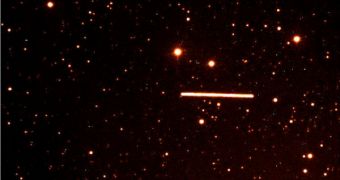Astronomers announce that a space object the size of a car will pass close to our planet today, February 9. They say that there is no chance of the asteroid slamming into our planet, or causing any other type of damage.
This is the second time in 5 days that a near-Earth object (NEO) zips past our planet, experts say. In spite of this increased frequency of such close-encounters, we are actually safe from impacts.
The object that will fly us by today has been dubbed 2011 CA7. It was discovered in early February, but even then scientists said that there is no risk of it entering the atmosphere. If it did, the space rock would be disintegrated before it reached the surface.
Calculations show that it will pass at a distance of about 64,300 miles (103,480 kilometers) away. The alert was issued by the NASA Asteroid Watch program, Space reports. The document states that the object is about 3 meters (nearly 10 feet) across.
Experts at the NASA Jet Propulsion Laboratory (JPL), in Pasadena, California, say that the object will make its closest approach at 2:25 pm EST (1925 GMT). The JPL manages the NEO database on which the Asteroid Watch program issues its warnings and advisories.
2011 CA7 will pass considerably farther away from Earth than asteroid 2011 CQ 1 did on February 4. The object moved within 3,400 miles (5471 kilometers) of the surface, but was only 1.3 meters across.
That asteroid would have also been entirely disintegrated, had it gotten the idea to enter Earth's atmosphere. To get a sense of scale, consider that the Moon is located about 238,900 miles (384,402 kilometers) away from us, Space reports.
NEO such as these two pass Earth every single day, but most of them are simply too small to detect with the capabilities we have installed. That is not to say that the technology to do so is not available.
What is really needed is a planetary early warning system, that would detect NEO heading this way before they become a problem, or take experts by surprise. On the bright side of things, objects that are large enough to cause damage are more easily detectable.
According to the JPL crew, NEO need to be at least 490 feet (nearly 150 meters) wide in order to pose a serious threat of actually reaching the planetary surface, and causing damage. Infrared telescopes are very good at detecting such object, the scientists add.

 14 DAY TRIAL //
14 DAY TRIAL //